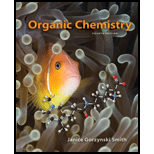
Concept explainers
(a)
Interpretation: The relationship between the molecules or ions in the given pair is to be stated.
Concept introduction: Isomers are defined as molecules having the same molecular formula but different arrangement of atoms.
(b)
Interpretation: The relationship between the molecules or ions in the given pair is to be stated.
Concept introduction: Isomers are defined as molecules having the same molecular formula but different arrangement of atoms.
(c)
Interpretation: The relationship between the molecules or ions in the given pair is to be stated.
Concept introduction: Resonance structure is a blend of two or more Lewis structures. Resonance structures are represented by a double headed arrow between the structures.
(d)
Interpretation: The relationship between the molecules or ions in the given pair is to be stated.
Concept introduction: Resonance structure is a blend of two or more Lewis structures. Resonance structures are represented by a double headed arrow between the structures.
Trending nowThis is a popular solution!

Chapter 1 Solutions
Connect Access Card For Organic Chemistry
- a. Give all the structural isomers of the hydrocarbons C5H12.(Hint: 3 isomers) b. Give all the structural isomers of the compound C3H5Cl which contains one C=C bond. (Hint: 3 isomers) c. One of the structural isomers in part b shows cis-trans isomerism. Draw and name this pair of isomers.arrow_forwardConsidering structures A–D, classify each pair of compounds as isomers, resonance structures, or neither: (a) A and B; (b) Aand C; (c) A and D; (d) B and Darrow_forwardDraw and upload a Lewis structure for CH4. as well as answer the following questions. -what is the hybrizatjon around the carbon? - what is the electron pair geometry for your drawing? -what is the bond angle between the C-H bonds of CH4 what is the molecular shape for CH4?arrow_forward
- Each carbon molecule can bond with as many as________ other atom(s) or molecule(s). a. one b. two c. six d. fourarrow_forwardConsidering structures A–D, classify each pair of compounds as isomers, resonance structures, or neither: (a) A and B; (b) A and C; (c) A and D; (d) B and D.arrow_forwardOrder these compounds in order of increasing carbon–carbon bond strength and in order of decreasing carbon–carbon bond length: HCCH, H2CCH2, H3CCH3.arrow_forward
- Draw an acceptable Lewis structure from each condensed structure, such that all atoms have zero formal charge. a. diethyl ether, (CH3CH2)2O, the rst general anesthetic used in medical proceduresb. acrylonitrile, CH2CHCN, starting material used to manufacture synthetic Orlon bersc. dihydroxyacetone, (HOCH2)2CO, an ingredient in sunless tanning productsd. acetic anhydride, (CH3CO)2O, a reagent used to synthesize aspirinarrow_forwardConsider the compound C₂H₃N. Which one of the structures in Figure 4 is the best representation of this compound based on your current knowledge? * A B C D All these structures are good representations of the compound.arrow_forwardgive some tips how to find significant resonance structures of organic moleculesarrow_forward
- How many electron pairs are shared when a triple bond exists between two carbon atoms? What must he the geometric arrangement around the carbon atoms in a triple bond? Draw the Lewis structure of a simple molecule that contains a triple bond.arrow_forwardFor resonance, there can be two resonance contributors or there could be one resonance hybrid. Are these just different ways to express the resonance? Do you have either two resonance contributors or a resonance hybrid? Or is the resonance hybrid just the resonance structure, but the version that is found in nature?arrow_forwardDraw an acceptable Lewis structure from each condensed structure, such that all atoms have zero formal charge. a. diethyl ether, (CH3CH2)2O, the first general anesthetic used in medical procedures b.acrylonitrile, CH2CHCN, starting material used to manufacture synthetic Orlon fibers c.dihydroxyacetone, (HOCH2)2CO, an ingredient in sunless tanning products d.acetic anhydride, (CH3CO)2O, a reagent used to synthesize aspirinarrow_forward
 Chemistry: The Molecular ScienceChemistryISBN:9781285199047Author:John W. Moore, Conrad L. StanitskiPublisher:Cengage Learning
Chemistry: The Molecular ScienceChemistryISBN:9781285199047Author:John W. Moore, Conrad L. StanitskiPublisher:Cengage Learning Introductory Chemistry: A FoundationChemistryISBN:9781337399425Author:Steven S. Zumdahl, Donald J. DeCostePublisher:Cengage Learning
Introductory Chemistry: A FoundationChemistryISBN:9781337399425Author:Steven S. Zumdahl, Donald J. DeCostePublisher:Cengage Learning World of Chemistry, 3rd editionChemistryISBN:9781133109655Author:Steven S. Zumdahl, Susan L. Zumdahl, Donald J. DeCostePublisher:Brooks / Cole / Cengage Learning
World of Chemistry, 3rd editionChemistryISBN:9781133109655Author:Steven S. Zumdahl, Susan L. Zumdahl, Donald J. DeCostePublisher:Brooks / Cole / Cengage Learning Living By Chemistry: First Edition TextbookChemistryISBN:9781559539418Author:Angelica StacyPublisher:MAC HIGHER
Living By Chemistry: First Edition TextbookChemistryISBN:9781559539418Author:Angelica StacyPublisher:MAC HIGHER Chemistry: An Atoms First ApproachChemistryISBN:9781305079243Author:Steven S. Zumdahl, Susan A. ZumdahlPublisher:Cengage Learning
Chemistry: An Atoms First ApproachChemistryISBN:9781305079243Author:Steven S. Zumdahl, Susan A. ZumdahlPublisher:Cengage Learning Chemistry & Chemical ReactivityChemistryISBN:9781337399074Author:John C. Kotz, Paul M. Treichel, John Townsend, David TreichelPublisher:Cengage Learning
Chemistry & Chemical ReactivityChemistryISBN:9781337399074Author:John C. Kotz, Paul M. Treichel, John Townsend, David TreichelPublisher:Cengage Learning





